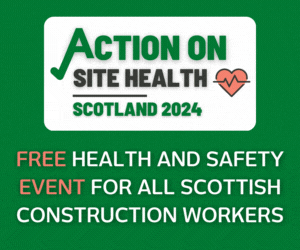Construction workloads in Scotland reach seven year high

High levels of private and public housing and private commercial activity has helped create the highest construction workload recorded since 2007, according to the Royal Institution of Chartered Surveyors (RICS).
The RICS UK Construction Market Survey Q3 2014 found that commercial workloads continued to make a strong recovery during Q3 2014 and also saw “positive signs” in the public housing sector.
Despite skills shortage concerns for quantity surveyors rising for the second consecutive quarter (now standing at a net balance of 42 per cent) commercial workloads continue to make a strong recovery throughout Scotland, with 39 per cent more surveyors reporting a rise in activity (up from a net balance of 26 per cent in Q2). This compares to a workload decline over the same quarter in 2012 (net balance of -9 per cent).
In Scotland, there were positive signs for workloads in the public housing sector, with a net balance of 22 per cent of surveyors reporting a growth in construction activity during Q3, the sharpest increase in since 2005. Workloads in the private housing sector also grew robustly across all parts of the UK with the London/South East region seeing the strongest growth.
However, while still positive, workloads in infrastructure saw much more balanced growth with 27 per cent more surveyors seeing activity levels rise across Scotland. Significantly for Northern Ireland, for the fourth consecutive quarter, infrastructure and private industrial sector growth in Northern Ireland remained flat (0 per cent net balance).
Across the whole of the UK, the main factors which were found to be limiting building activity were a shortage of labour, followed by concerns over finance and shortage of materials (both a net balance of 58 per cent) followed by planning and regulation factors (a net balance of 51 per cent). In particular, demand for brick layers grew significantly on the previous quarter, with a net balance of 71 per cent of respondents now saying that they are in great demand (compared to 59 per cent in Q2 2014).
However, despite the concerns, the strength and breadth of the growth that is being reported across Scotland is promising and feeding expectations for further growth over the coming year. As a result, 43 per cent more surveyors expect to see profits increase, rather than decrease, and 38 per cent of respondents expect to take on more people in response to the rising workloads during the next 12 months.
Sarah Speirs, director RICS Scotland said: “Unprecedented housing demand and the bounce back from a very deep recession are translating into prominent growth in workloads throughout Scotland. With a lack of housing supply identified in the recent Scottish Housing Commission reports, it is encouraging to see a growth in construction activity across housing sectors.
“Of course factors impacting construction activity, such as skill shortages and material shortages, must be addressed if we are to avoid capacity constraints, but it is equally important that the underlying framework for effective planning and delivery of projects is in place to ensure long-term construction growth that is evenly spread across the country.”
Despite the positive figures, caution remains within the industry as the recovery begins to take hold.
David Taylor FRICS, CBA QS Ltd, Glasgow added: “There is an ever increasing air of confidence but market participants still seem reluctant to commit to some of the larger projects. We are sensing caution on funding even though the uncertainty which was present before the referendum has dissipated.”





















